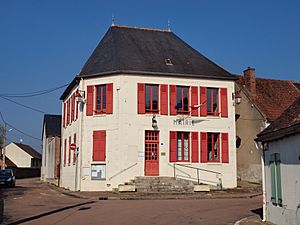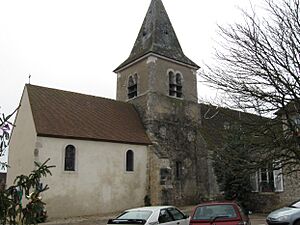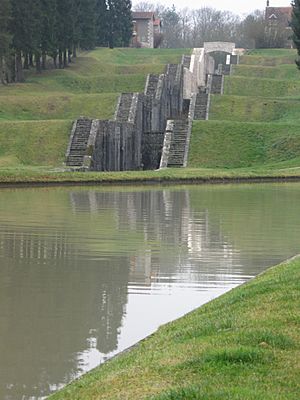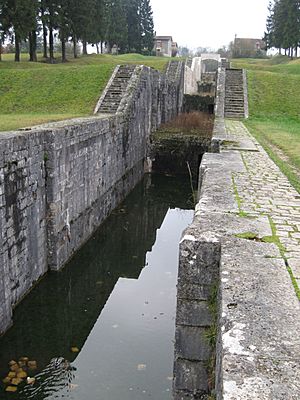Rogny-les-Sept-Écluses facts for kids
Quick facts for kids
Rogny-les-Sept-Écluses
|
||
|---|---|---|
|
The town hall in Rogny-les-Sept-Écluses
|
||
|
||
| Country | France | |
| Region | Bourgogne-Franche-Comté | |
| Department | Yonne | |
| Arrondissement | Auxerre | |
| Canton | Cœur de Puisaye | |
| Area
1
|
32.59 km2 (12.58 sq mi) | |
| Population
(Jan. 2021)
|
Lua error in Module:Wd at line 1,575: attempt to index field 'wikibase' (a nil value). | |
| Time zone | UTC+01:00 (CET) | |
| • Summer (DST) | UTC+02:00 (CEST) | |
| INSEE/Postal code |
89324 /89220
|
|
| Elevation | 135–186 m (443–610 ft) | |
| 1 French Land Register data, which excludes lakes, ponds, glaciers > 1 km2 (0.386 sq mi or 247 acres) and river estuaries. | ||
Rogny-les-Sept-Écluses is a small town, also called a commune, located in central France. It's found in the Yonne area, which is part of the Bourgogne-Franche-Comté region. The town's special name, "Sept-Écluses," means "seven locks" in French. This is because of the amazing set of seven locks on the Briare Canal that are right there!
Contents
Exploring Rogny's Location
This commune is about 50 kilometers (31 miles) west of Auxerre. It is crossed by two important waterways: the Loing river and the Briare Canal. Rogny-les-Sept-Écluses is also about 20 kilometers (12 miles) north of Gien and 140 kilometers (87 miles) south of Paris. The town is nestled in a natural area known as Puisaye.
A Look Back at Rogny's Past
Before 1978, the town was simply called Rogny. Its name was changed to Rogny-les-Sept-Écluses to highlight its famous monument: the seven locks.
Ancient Times: Roman Connections
People have lived in this area since the time of the Roman Empire. Old Roman coins and medals have been found along an ancient Roman road. Some of these coins showed images of Emperor Constantine (who ruled from 306 to 337 AD) and a Gaulish leader named Tetricus (from 268 AD).
Medieval Life in Rogny
During the Middle Ages, the lower part of the village was quite wet and marshy. Because of this, most villagers lived on higher ground, around the church. Records from the 11th century show that the village was part of the Roignacum parish. This is likely where the name Rogny came from.
Saint-Loup Church: A Historic Landmark
The Saint-Loup Church stands on the hill where the original village was built. It still overlooks the town today. The church dates back to the 12th century, though it has been changed many times over the years. It still has its original Romanesque style porch.
One of the church's most special items is a painting called Les Pèlerins d’Emmaüs (The Pilgrims of Emmaus). It was painted in 1757 and was declared a historical monument in 1908. The painting is believed to be the work of Adrien Lebeau. The church also has a large bell, named Isabelle, which was made in 1659 and measures 1.20 meters (about 4 feet) across.
The Seven Locks and the Briare Canal: A Grand Project
The Briare Canal and its amazing set of seven locks (called sept écluses in French) were part of a huge project. King Henry IV and his minister Sully wanted to connect the Mediterranean Sea to the English Channel. They planned to do this using a network of canals and rivers. The locks were built to link the Loire river system to the Seine river system.
The idea to build six locks (a seventh was added later) to cross the Loing Valley came from Hugues Cosnier. This is why the town is called Rogny-les-Sept-Écluses. Cosnier chose Rogny for this big project because there were many ponds nearby. The water from these ponds was needed to operate the locks.
Construction of both the locks and the Briare Canal began in 1604. It was a massive undertaking, requiring nearly 12,000 workers. These workers needed places to live in the town. During the Thirty Years' War, construction stopped, and about 6,000 soldiers came to guard the building site. Stealing materials was a big problem back then!
The locks and the nearby canal finally opened for boats in 1642. At first, it was called "Canal de Loyre en Seyne," but it became known as the Briare Canal in 1666. These locks were the first of their kind built in France. The lives of the villagers became closely linked to the boats and navigation. They were proud to guide the boats along the towpath.
In 1822, work was done to make the locks more modern. However, they were closed in 1887 after new locks were built. Each of the old locks is 27 meters (88 feet) long, making the total length of the seven locks 238 meters (780 feet). They are 4.32 meters (14 feet) wide. In 1983, these impressive locks were recognized as a national historical monument.
Fun Events in Rogny
Since 1967, Rogny-les-Sept-Écluses has held a special event every year at the end of July. It's a fantastic pyrotechnics (fireworks) show right next to the old locks. Before the main fireworks display, there are also music and comedy performances for everyone to enjoy!
See also
 In Spanish: Rogny-les-Sept-Écluses para niños
In Spanish: Rogny-les-Sept-Écluses para niños









